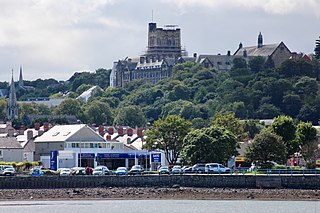
Bangor is a cathedral city and community in Gwynedd, North Wales. It is the oldest city in Wales. Historically part of Caernarfonshire, it had a population of 15,100 at the 2021 census. Landmarks include Bangor Cathedral, Bangor University and Garth Pier. The Britannia and Menai Suspension bridges connect the city to the Isle of Anglesey.

Bethesda is a town and community in Gwynedd, Wales. It is on the banks of Afon Ogwen and on the edge of Snowdonia. It is 5 miles (8.0 km) from Bangor.
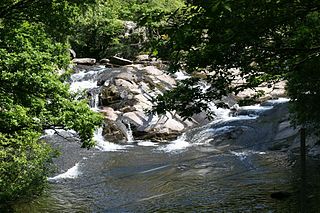
Afon Ogwen is a river in north-west Wales draining from some of the greatest peaks in Snowdonia before discharging to the sea on the eastern side of Bangor, Gwynedd.

The Penrhyn Quarry Railway was a narrow-gauge railway in Caernarfonshire, Wales. It served the Penrhyn quarry near Bethesda, taking their slate produce to Port Penrhyn, near Bangor. The railway was around six miles (9.7 km) long and used a gauge of 1 ft 10+3⁄4 in.

The Padarn Railway was a narrow-gauge railway in North Wales, built to the unusual gauge of 4 ft. It carried slate seven miles (11 km) from Dinorwic Quarry to Port Dinorwic. The line opened on 3 March 1843, replacing the Dinorwic Railway. It initially used horses, but was converted to steam haulage on 23 November 1848. The railway was formally titled the Dinorwic Quarries Railway or Dinorwic Quarry Railway, but informally "Padarn Railway" was widely used.

Dyffryn Ogwen, or Ogwen Valley, is a valley mostly located in the Welsh county of Gwynedd. The upper section of the valley, east of Llyn Ogwen, lies in the county of Conwy.

George Sholto Gordon Douglas-Pennant, 2nd Baron Penrhyn, was a landowner who played a prominent part in the Welsh slate industry as the owner of the Penrhyn Quarry in North Wales.

The Penrhyn quarry is a slate quarry located near Bethesda, North Wales. At the end of the nineteenth century it was the world's largest slate quarry; the main pit is nearly 1 mile (1.6 km) long and 1,200 feet deep, and it was worked by nearly 3,000 quarrymen. It has since been superseded in size by slate quarries in China, Spain and the USA. Penrhyn is still Britain's largest slate quarry but its workforce is now nearer 200.

Richard Pennant, 1st Baron Penrhyn, was a Welsh politician and nobleman who served as an MP in the British Parliament, representing Petersfield and Liverpool for 29 years between 1761 and 1790. He was the owner of Penrhyn Castle, an estate on the outskirts on Bangor, North Wales.
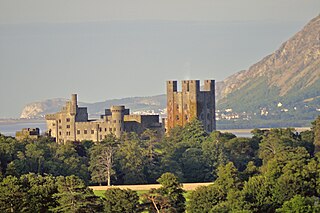
Penrhyn Castle is a country house in Llandygai, Bangor, Gwynedd, North Wales, constructed in the style of a Norman castle. The Penrhyn estate was founded by Ednyfed Fychan. In the 15th century his descendent Gwilym ap Griffith built a fortified manor house on the site. In the 18th century, the Penrhyn estate came into the possession of Richard Pennant, 1st Baron Penrhyn, in part from his father, a Liverpool merchant, and in part from his wife, Ann Susannah Pennant née Warburton, the daughter of an army officer. Pennant derived great wealth from his ownership of slave plantations in the West Indies and was a strong opponent of attempts to abolish the slave trade. His wealth was used in part for the development of the slate mining industry on Pennant's Caernarfonshire estates, and also for development of Penrhyn Castle. In the 1780s Pennant commissioned Samuel Wyatt to undertake a reconstruction of the medieval house.

Edward Gordon Douglas-Pennant, 1st Baron Penrhyn, was a Scottish landowner in Wales and Jamaica, and a Conservative Party politician. He played a major part in the development of the Welsh slate industry.
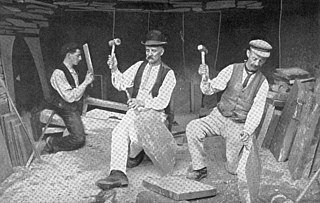
The existence of a slate industry in Wales is attested since the Roman period, when slate was used to roof the fort at Segontium, now Caernarfon. The slate industry grew slowly until the early 18th century, then rapidly during the Industrial Revolution in Wales until the late 19th century, at which time the most important slate producing areas were in northwest Wales. These sites included the Penrhyn Quarry near Bethesda, the Dinorwic Quarry near Llanberis, the Nantlle Valley quarries, and Blaenau Ffestiniog, where the slate was mined rather than quarried. Penrhyn and Dinorwig were the two largest slate quarries in the world, and the Oakeley mine at Blaenau Ffestiniog was the largest slate mine in the world. Slate is mainly used for roofing, but is also produced as thicker slab for a variety of uses including flooring, worktops and headstones.

The Penrhyn Castle Railway Museum is a museum of industrial railway equipment, located at Penrhyn Castle near Bangor in Wales.

Dinorwic quarry is a large former slate quarry, now home to the Welsh National Slate Museum, located between the villages of Llanberis and Dinorwig in Wales. At its height at the start of the 20th century, it was the second largest slate quarry in Wales, after the neighbouring Penrhyn quarry near Bethesda. Dinorwic covered 700 acres (283 ha) consisting of two main quarry sections with 20 galleries in each. Extensive internal tramway systems connected the quarries using inclines to transport slate between galleries. Since its closure in 1969, the quarry has become the site of the National Slate Museum, a regular film location, and an extreme rock climbing destination.
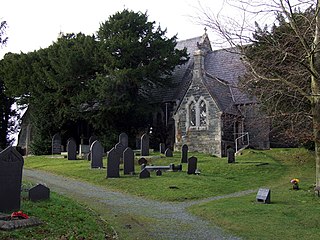
Tregarth is a village near Thomas Telford's A5 London to Holyhead road between the town of Bethesda and the city of Bangor in Gwynedd, north Wales. It is in Llandygai Community. It had a population of over 1,300 as of the 2011 census..

The Eigiau Tramway might refer to the Eigiau Quarry Tramway or to the Eigiau Reservoir Tramway.

Llandygái is a small village and community on the A5 road between Bangor and Tal-y-bont in Gwynedd, Wales. It affords a view of the nearby Carneddau mountain range. The population of the community taken at the 2011 Census was 2,487. Llandygái community includes nearby Tregarth and Mynydd Llandygái and also the pass of Nant Ffrancon.

The Afon Cegin is a small river draining parts of North Wales and discharging to the Menai Strait at Porth Penrhyn. Its name means Kitchen River in English.
The Bethesda branch line was a 4+1⁄4-mile (6.8 km) railway branch line between Bangor and Bethesda in Gwynedd, North Wales. Its primary purpose was to bring quarried slate down to the main line for onward transport.

Gilfach Ddu are a series of well preserved Grade I listed industrial buildings built to serve the Dinorwic slate quarry near Llanberis in Caernarfonshire, North Wales. The workshops are a complex of repair and maintenance buildings, that were built in 1870 to build and maintain the machinery used in the quarry. The complex includes saw sheds, patternmaking shops, a foundry with copula, blacksmiths shops, fitting shops, stores, engine sheds, a canteen, the chief engineers house, a hand operated crane and two waterwheels which provided the site with its power. Since 1972 the buildings have housed the National Slate Museum.



















